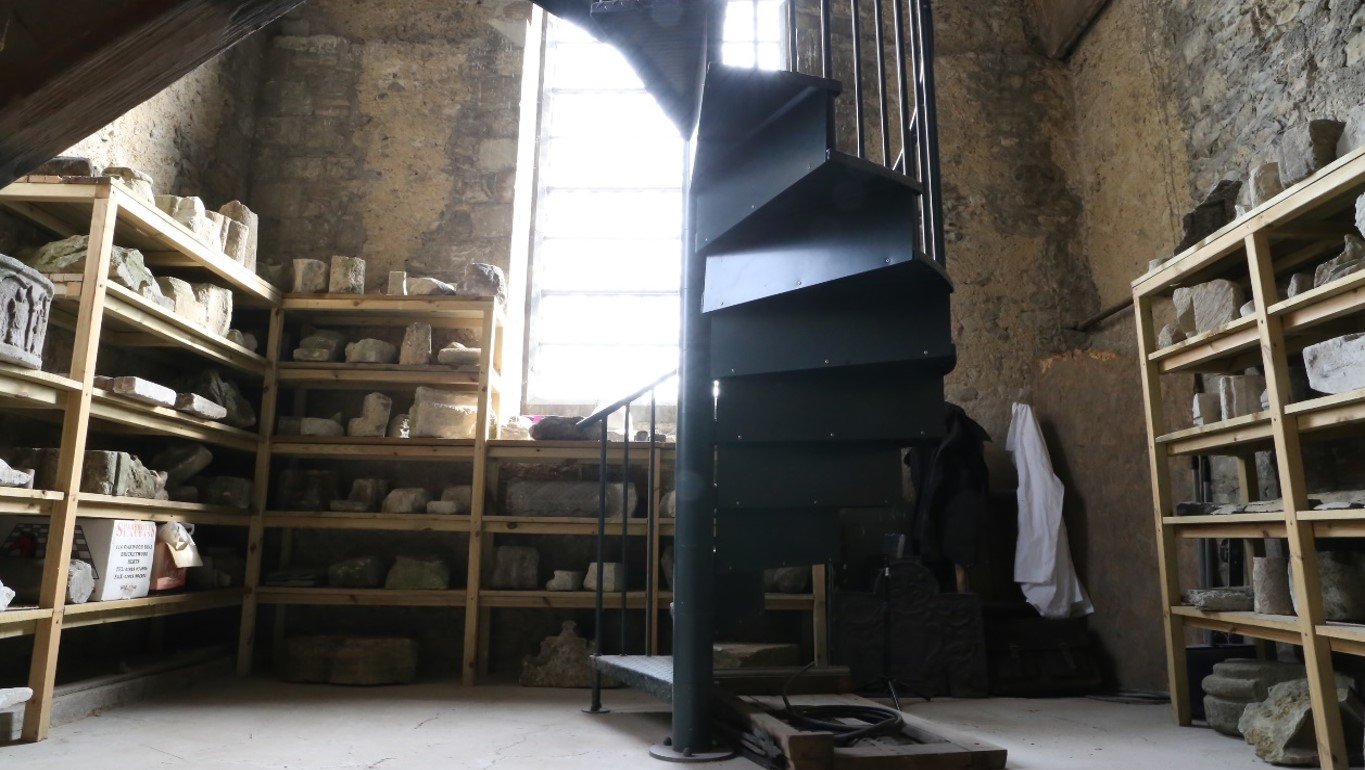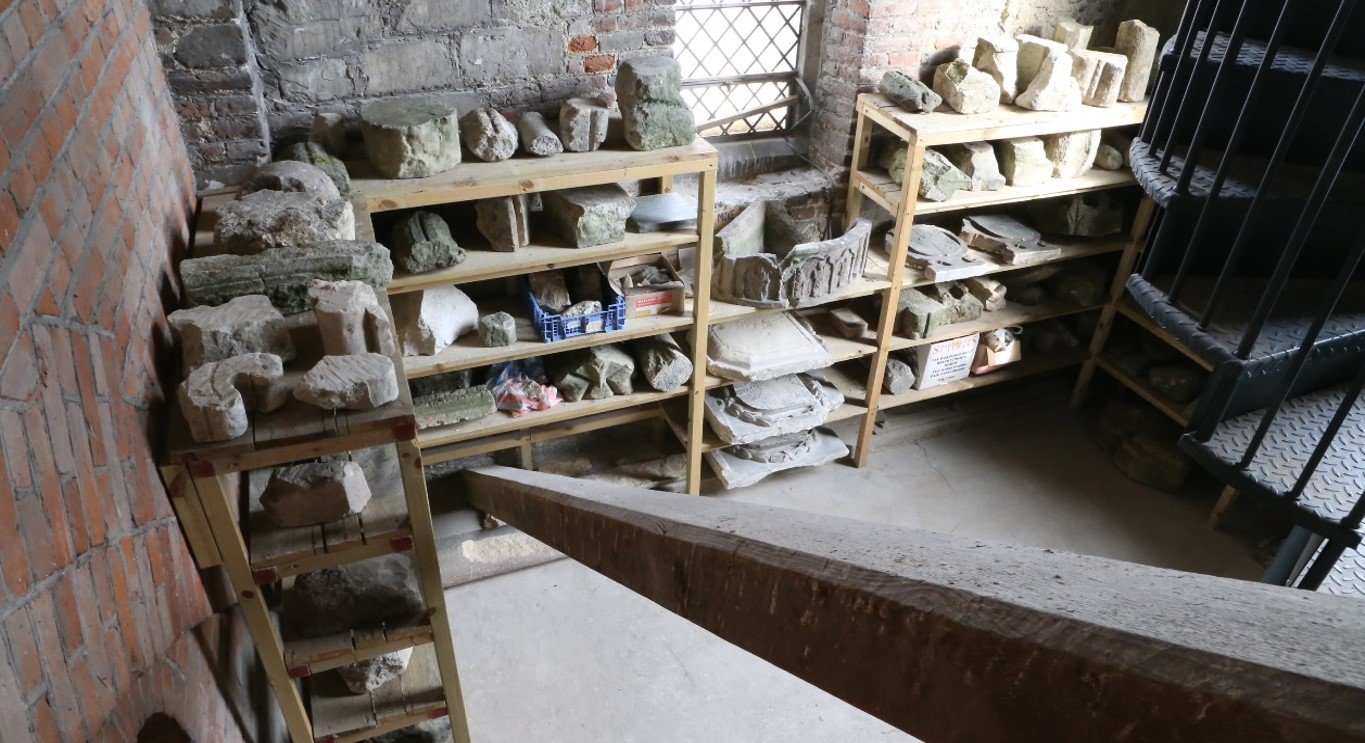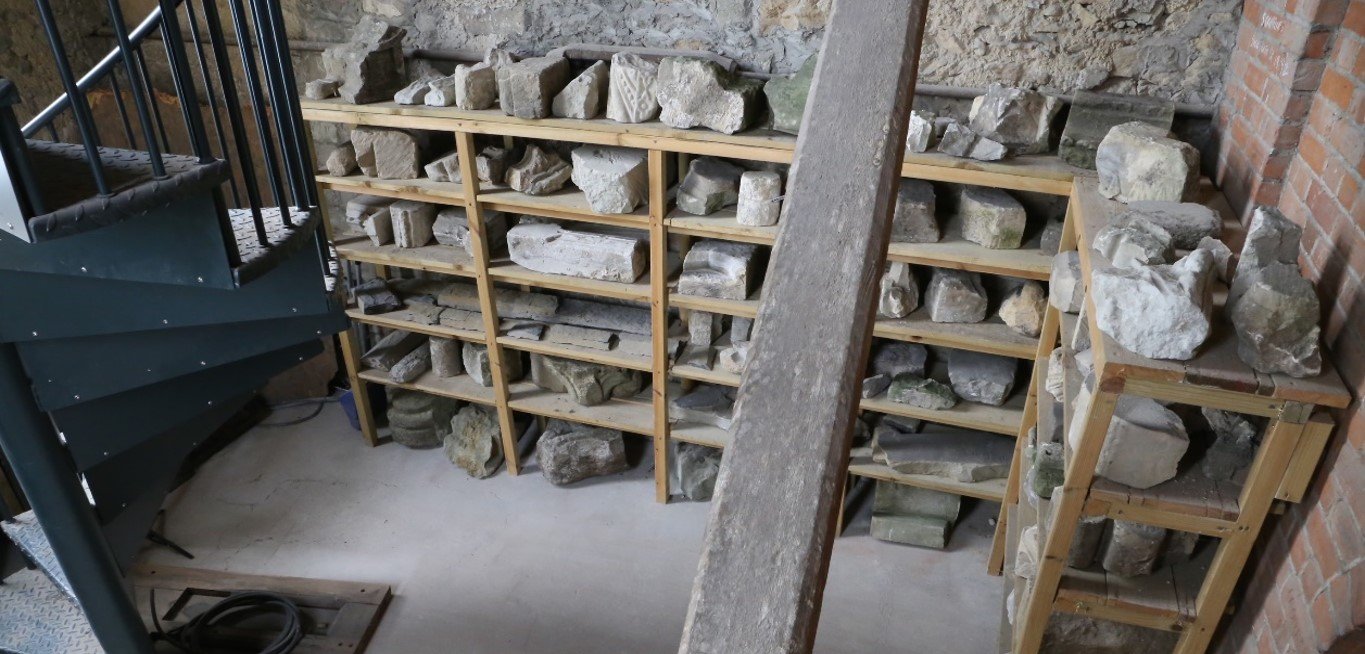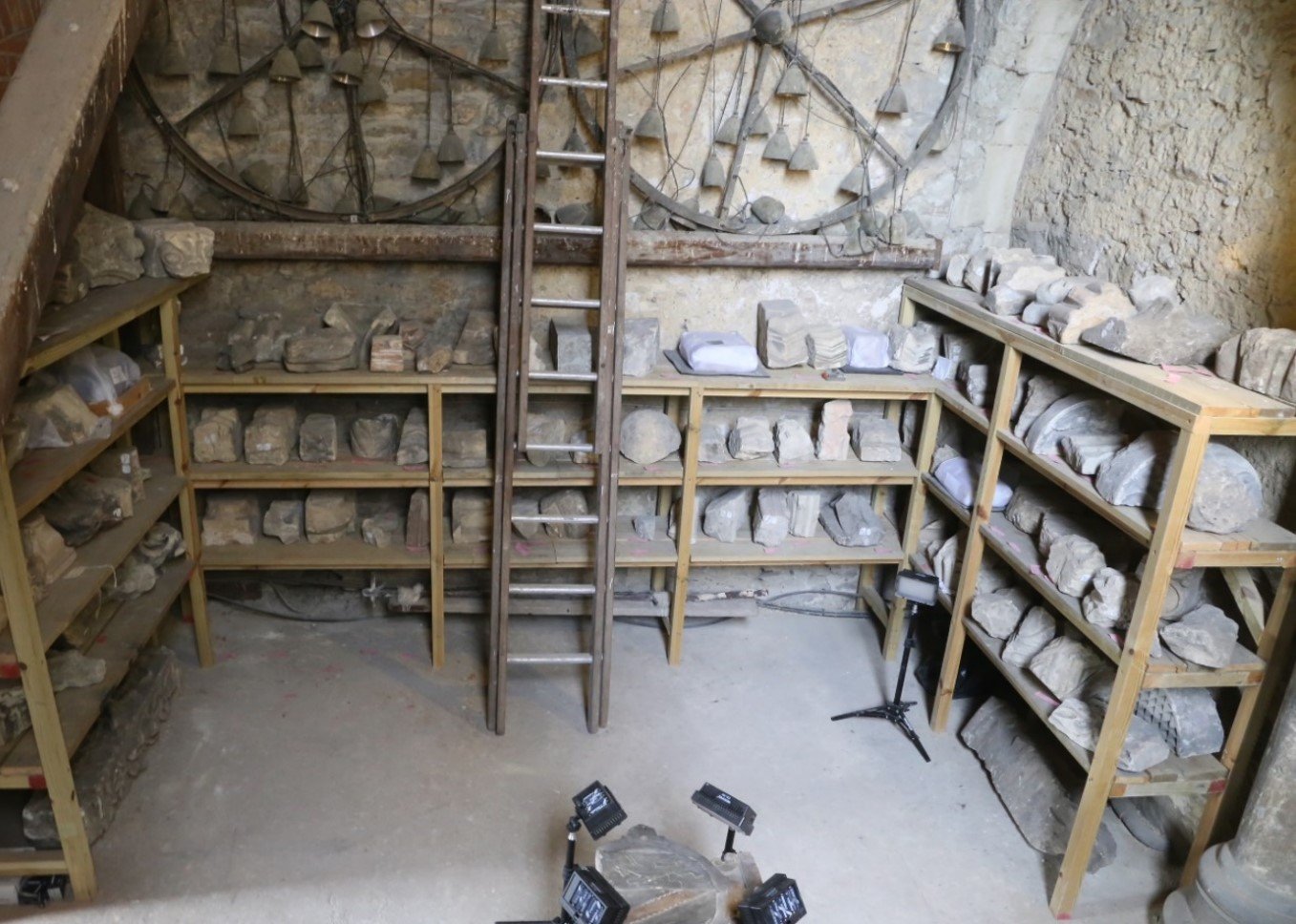New Lapidarium
/
New Lapidarium
September 5, 2021
Jacob Scott reports on the move of the Lapidarium stone fragment collection from its previous siting to a new more suitable space. Featured in The Friends of Rochester Cathedral Annual Report 2021.
In 1981 the Cathedral Lapidarium was established in a room over the North Quire Transept known as the Treasury, largely due to the efforts of Anneliese Arnold, wife of The Very Revd John Arnold, Dean of Rochester 1978-1989.[1] It is thanks to Arnold and others' extraordinary efforts that much of the Lapidarium collection is preserved and provenanced today. The collection has doubled in size in the intervening years as sculptural fragments have been recovered from excavations and gathered from around the Precinct. A previously unused space over the South Quire Transept was developed into a new housing for this collection in 2018. A resurvey of this remarkable collection and an updated photographic record producing detailed three-dimensional models of each of the 500 sculptural fragments, also extending to the 350 in-situ spolia (reused sculptural fragments) around the Cathedral and Precinct, is now available through the Cathedral website, joining the hundreds of other models of collections, items and architecture recorded during the Virtual Cathedral Project.[2]
Figure 1, A-K. Screenshots of 3D models of the some of the finest items in the Lapidarium collection.
Forming the bulk of the collection, many Romanesque sculptural decorations were removed from the spandrels either side of the large c.1490 Great West Window during restoration work under architect Lewis Nockalls Cottingham in 1825. These were spolia moved from their original locations in the c. 1150 west façade. Cottingham's sketches record the locations of the stones as they were removed, apparently with the intention that they be replaced in the future, although no such campaign occurred). Although interpretation of some elements is ambiguous, the accession of several of the finest Romanesque grotesques to the Lapidarium collection can be traced to Cottingham's sketches (for example, Fig. 1 A-C). The sketches also include stones and moulding forms no longer evident within the Lapidarium collection today.
Also in Cottingham's time, ‘the brick wall that had (we know not when) been built up over the doorway, leading to St. William's Chapel, and that reached quite up to the roof, was taken down’.[4] A tomb of an unknown person was discovered with an exceptional painted effigy of Bishop John de Sheppey (d.1360), blocked up with rubble and a number of the most exceptional sculptural fragments now in the Lapidarium collection, of which sketches were produced at the time. The fragments originated from at least three separate monuments. There is little to doubt the traditional interpretation that one of these was a figurative architectural screen in Bishop John de Sheppey's chantry chapel (Fig. 1 D-F). This valuable record shows that many fine items within the collection have suffered considerable damage and loss of material in the intervening two centuries, and eight fragments are no longer identifiable within the collection. Nevertheless, the fragments which remain are exceptional examples of 14th century sculpture and feature much of their vivid and fine painted polychromy. At least two Romanesque Caen-stone pieces featuring expensive blue paint are now posited to have originated from the shrine of St William of Perth, proximate to their discovery (Fig. 1 G, H). Fragment G features the torso of a figure bearing a large pilgrim's bag.
It is recorded that the collection of fragments taken from the west façade during Cottingham's time was consulted during John Person's restoration some 80 years laterS. Several heavily weathered 12th-century foliate voussoirs in the collection likely resulted from Person's restoration. In 1898 William St John Hope noted in his Architectural History: In the vault beneath the chapter-room are deposited a large number of carved and moulded architectural fragments, some of considerable beauty and interest, that have been found from time to time at successive "restorations". Until quite lately these were scattered about the crypt, but have now been reduced to some kind of order by the care of Mr. George Payne, F.S.A. They have yet to be sorted and labelled, before all record of them is forgotten 6 Payne's efforts may explain the faint blue chalk numbers still surviving on some Romanesque fragments today, but unfortunately no catalogues or notes are known to survive from his time. What would become much of the Lapidarium collection began to appear in photographs of the north end of the Undercroft and the room beneath the then Chapter Room from the late 19th and early 20th centuries. These photographs have been used to further provenance and identify the date of accession of items to the collection).
The area below the Chapter Room became a vestry before World War I and the Undercroft was used as an air-raid shelter through both wars. In 1980, Arnold noted that, despite Payne's efforts, 'the stones had since been scattered again, a few preserved elsewhere in the cathedral, but many simply piled up on a ledge inside the ruined Chapter House, exposed to the weather. Some of the best have disappeared, doubtless taken as souvenirs or ornaments"". At Arnold's instigation, following discussions with Cathedral Architect Emil Godfrey, in 1981 the Lapidarium was established in the Treasury over the North Quire Transept. A 1994 portfolio in the Chapter Library compiled by Arnold is a valuable record of this project. In 1986 Cathedral Campers» redecorated the space and repaired the walls and floor. Cathedral Surveyor Martin Care designed the shelving, which was installed by the Royal School of Military Engineering, and Claire Walker and Leslie Hudson are credited with collecting 245 stones and moving them up to the space via a spiral staircase in the North Quire Transept.
Arnold's catalogue of the stones, begun in 1992, records 252 stones including nine very large stones remaining around the Cathedral floor at that time, as well as smaller collections of tile, wood and assorted finds from 20th century excavations. This 1992 catalogue corresponds to Tipp-Ex markings on the stones and it is this numbering system which has been extended by this survey, although Tipp-Ex is no longer used!
As items have been added to the collection from various excavations and works, the Lapidarium now includes some of the most archaeologically significant sculpture of the Cathedral including three Anglo-Saxon fragments representing all the known surviving pre-Conquest sculpture in Rochester. The earliest, from the 8th century bearing the hind-quarters of a beast and an interlace panel, was recovered during the c.1880 underpinning of the west façade in advance of Pearson's restoration (Fig. 1 I). A fragment of an 8th or 9th century cross, recovered from the vicinity of Prior's Gate House in 1974, shows reddening characteristic of fire damage (Fig. 1 J). The latest of the three, an early 11th century fragment of a standing headstone still bearing evidence of its vivid polychrome, was identified by Mary Covert in 1984 reused at the base of the Nave SW Tower. One side of the headstone, carved in the Scandinavian Ringerike style, features what is probably another beast, intertwined in foliage or locked in combat with a serpent (Fig. 1 K)(8) In 2014, during the conservation of the paintings on the Undercroft vaulting, tufa spolia were recovered from the vaulting which featured preserved fresco from the turn of the twelfth century, possibly originating in Bishop Gundulf's square east end, the foundations of which were uncovered during the 2014 excavations. The largest fragment, an entire voussoir, bears the shoulders and halo of a bishop saint, possibly Paulinus or Ithamar (Fig. 1 L).
In around 2010 a programme of cleaning, consolidation and classification of the stones was started by London City & Guilds students of stone conservation. Each academic year a few stones are transferred, so that a significant portion of the stones catalogued in 1992 have now been conserved.
The collection has been supplemented with dozens of fragments recovered from various excavations, many from those within the Cloisters and Undercroft in 2014. Stones have been unearthed by the gardeners or recovered from reuse as garden features. Additional fragments, excavation finds and historic miscellanea accumulated in the Treasury Lapidarium to the point where navigability of the space became restricted.
In 2018 a previously unused chamber over the South Quire Transept was refurbished into the new housing for the Lapidarium collection with the installation of a mezzanine floor, access from the roof and new shelving. The move of the entire contents of the Lapidarium to the new chamber and the gathering of sculptural fragments from around the Precinct afforded by the increased shelf space were completed in the summer of 2021. The shelves previously installed in the Treasury have been reused on the new floor for boxes of smaller excavation finds, now a sizeable part of the collection. The appropriate housing and preservation of the Lapidarium collection, now including the entirety of identified sculptural fragments, represents a significant achievement by many parties over several decades. (Fig. 2).





Taking a cue from Arnold's initial investigations, the Lapidarium database has been expanded to include a comprehensive 3D record of the 350 in-situ spolia reused around the Cathedral and Precinct. Together these corpora are vital in understanding the medieval fabric of the Cathedral and Cloisters. The west triforium passage of the Nave North Aisle is largely composed of other Romanesque architectural fragments from the west façade replaced during the insertion of the Great West Window. Scaffolding along the north side of the Cathedral in recent years has provided once-in-a-lifetime access for recording. The Nave north and south walls incorporate fragments of former Romanesque windows and the Perpendicular clerestory features dozens of shaft drums reused from the former Romanesque clerestory. Dozens of marble sculptural fragments from the twelfth-century cloisters are reused in the external facing of the Old Deanery, accessed using the 10m aerial-work-platform funded by the Friends in 2007 and still going strong! Together with the Lapidarium collection, this sizeable database is now available online in 3D (via www.rochestercathedral.org/lapidarium), preserving and opening these collections for further study as we piece together our understanding of the medieval Cathedral.
Jacob Scott
Research Guild
Featured in The Friends of Rochester Cathedral Annual Report 2021.
Footnotes
1. Anneliese Arnold, The Lapidarium, in The Friends of Rochester Cathedral Report for 1990- 91, р. 21-22.
2. See www.rochestercathedral.org/lapidarium.
3. Arnold, A., 1994, The Lapidarium, unpublished portfolio, Rochester Cathedral Chapter Library.
4. Notes and Observations of the Reverend Dr. [Robert] Stevens, Dean of Rochester, which may be found useful to succeeding Deans, Medway Archives DR/Acz/1 (1820-43), pp. 65 and 67-69. An account is also given in the Gentleman's Magazine for January 1825, p.76-77.
5. Holbrook, D., 1994, Rochester Cathedral 1540-1983; A record of maintenance repair alteration restoration decoration furnishing and survey of the fabric. Archive report, Rochester Cathedral Library. Available at rochestercathedralresearchguild.org/ 1994-01.
6. W. H. St John Hope, The Architectural History of the Cathedral Church and Monastery of St. Andrew at Rochester, Archaeologia Cantiana, Vol. 23 (1898), p.328.
7. Cathedral Camps was a charity which used young volunteers, known as Cathedral Campers, to help with the conservation of cathedrals and churches.
8. Mary Covert, An Exciting Find, in The Friends of Rochester Cathedral Report for 1988, p. 10-11 and back cover.
The Friends of Rochester Cathedral were founded to help finance the maintenance of the fabric and grounds. The Friends’ annual reports have become a trove of articles on the fabric and history of the cathedral.
The repository of stone comprises over 500 sculptural fragments from the eighth to the nineteenth-centuries.
Keeping the Cathedral standing, warm, lit, beautiful and ready to receive worshippers and visitors is a never-ending task.








